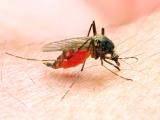A study today in the journal mBio shows that, in addition to circulating in blood, Plasmodium vivax, a parasite that causes malaria, also accumulates in bone marrow.
P vivax causes most malaria infections outside of sub-Saharan Africa and is a significant public health burden. Though not as deadly as P falciparum, P Vivax still infects tens of thousands of people annually, sometimes leading to severe and fatal symptoms.
This is the first time P vivax has been detected in bone marrow, and the discovery paints a more insidious picture of the parasite. By using bone marrow as a reservoir, the parasite is able to replicate mostly undetected in a person. P vivax gametocytes, cells that are essential for transmission, mature quickly in the bone marrow and can be transmitted to mosquitoes before the onset of illness.
The scientists, mostly from the United States, made their discovery by studying the transcriptomes of P vivax to identify blood-borne proteins that correspond to different stages of the parasite's life cycle. They then took blood samples from patients with malaria, which showed a fraction of P vivax life stages were underrepresented in the blood, meaning they were accumulating somewhere else in the body.
The scientists performed autopsies on 14 monkeys who died with malaria infections, sampling tissue from the animals' bone marrow, lung, liver, brain, intestine, and fat. A large percentage of P vivax was housed in the bone marrow.
"We think this is a conserved phenotype in Plasmodium parasites. Essentially that the bone marrow represents a major reservoir for parasite growth and transmission," Matthias Marti, PhD told CIDRAP News. Marti is the lead author of the study and a professor at the Harvard School of Public Health and the University of Glasgow.
Marti said P falciparum has also been found to accumulate in bone marrow.
Bone marrow represents new target
"We need to new diagnostic tools to estimate parasite burden in the marrow from markers in the bloodstream, as direct bone marrow diagnosis is not feasible," Marti said. Although the science isn't there yet, targeting the bone marrow and the parasite's gametocytes could be a game-changer for reducing malaria burden, he added.
"Gametocytes don't make anyone sick, but they're the mode of transmission," explained Anne Parker Frosch, MD, from the Division of Infectious Disease and International Medicine at the University of Minnesota.
"Medication is lousy at killing gametocytes, so targeting gametocytes could interrupt transmission."
See also:
May 8 mBio study


















